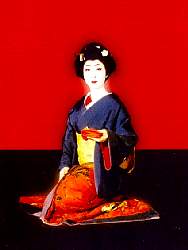Osaka, Kyoto and Kobe were
known as the Kamigata area, so the dances created here are
called Kamigata-mai.
Drawing on 12th-century traditions established by courtesan dancers and
singers at banquets in Kyoto and namely based on
the dancing tradition of noh, kabuki
and kyogen, but also referring to the techniques
of puppet movements in bunraku, it was born and
developed in the 16th century.
Kamigata-mai is at times called jiuta-mai,
because it is performed to the accompaniment of jiuta
(popular song sung by the Kamigata people), the oldest form of shamisen music.
While noh, kyogen and
bunraku as well are performed by males, kamigata-mai
origins in the dances popular with the court ladies,
"Maiko"
or "Geisha".
Developed mainly as a chamber art, it was performed in zashiki
(a Japanese-style room with tatami mats) to entertain
special guests. That is why at times it is also called "zashiki-mai".
It enjoyed the patronage of highly aesthetically sensitive
personalities.
|
|
As
a chamber art, kamigata-mai exhibits a sharp contrast to
world-famous kabuki dances which are put
on in large theatres to the accompaniment of nagauta which
is theatre-oriented music.
|
 |
Kamigata-mai is performed in a
subdued, tranquil and dignified way,
giving major importance to the external expression's of one's
innermost sentiments. kabuki dances instead are
more animated, vigorous and sometimes even boisterous.
click picture to enlarge!
|
|
|
 For more information about
Japanese culture the following organisations are of help: Japan
Information Network (JIN), Japan Center for Intercultural Communication
(JCIC) and The Japan Foundation. They are all linked through Web Japan,
a 'Gateway for all Japanese Information'. For more information about
Japanese culture the following organisations are of help: Japan
Information Network (JIN), Japan Center for Intercultural Communication
(JCIC) and The Japan Foundation. They are all linked through Web Japan,
a 'Gateway for all Japanese Information'.
Here you will find a short and comprehensive Overview of
Japanese Dance
and an
Overview of Japanese Music.
|
noh / noh-gaku / sarugaku-noh
One of the traditional performing arts of mainland Japan.
A song-and-dance drama that developed from the medieval sarugaku,
the form was perfected in the Edo period
(1615-1868), which marked 250 years of complete isolation from the rest
of the world, during which
time Japan's unique cultural heritage developed away from outside
influences.
The subject matter is classical, and the performers wear masks.
Kamigata-mai was influenced by shimai
a form of noh theater performed without masks or costumes, with
skill expressed through posture and the use of a folding fan
kabuki
One of the traditional performing arts of mainland Japan: a
song-and-dance drama that was born during the Edo period as an art form
of the masses.
Originally played by street formers, from the Meiji period
(1868 - 1912) onwards the form became classical and stylized and it
is this change from the street to the theater that is called kabuki.
Even today new interpretations and original plays are tried out, and
performances are staged for the popular audience.
kyogen
In general terms this means any art involving spoken lines, but it
usually refers to noh kyogen. Like Noh, it
is an old art form whose origins lie in sarugaku: subject
matter taken from daily life is treated in comic manner.
bunraku
One of the traditional performing arts of Japan. The term refers to the
puppet shows (puppet theatre) of Osaka. Like kabuki
this was popular art for the common people, born during the Edo period,
and together with Noh these three
are known as the sandaikokugeki, or three great
national forms of theatre.
shamisen
It is a three string instrument and came to Japan during the Edo
period , it was the time of
a growing merchant class as well as a samurai (warrior)
class that did not have much to do since war was over, except entertain
themselves. It quickly became popular as the best instrument for
entertainment.
Osaka
has always been a merchant city. In the Edo era, it
was especially a rice market.
Merchants came from all over Japan to sell rice in Osaka. They would
host parties for people including samurai and big customers. Since
samurai
all studied noh drama, the jiuta-mai
dancers chose famous parts of the noh
plays and included them in jiuta-mai dances. Jiuta-mai
were always changed to please special guests.

manasvi.com
2003-2004
|


 For more information about
Japanese culture the following organisations are of help: Japan
Information Network (JIN), Japan Center for Intercultural Communication
(JCIC) and The Japan Foundation. They are all linked through Web Japan,
a 'Gateway for all Japanese Information'.
For more information about
Japanese culture the following organisations are of help: Japan
Information Network (JIN), Japan Center for Intercultural Communication
(JCIC) and The Japan Foundation. They are all linked through Web Japan,
a 'Gateway for all Japanese Information'.